| |
Edmund
Ignatius Rice-—The Irish Ignatius Loyola!! |
|
The Irish Ignatius
Loyola was named Edmund Rice. He was the founder of an order of lay
MONKS whose constitution mirrored that of the perpetually banned Jesuits.
After the Jesuits
were perpetually banned by Pope Clement XIV, they were forbidden to
operate openly in Latin Church countries. Many
of these firebrands found a refuge in the British Empire . . . and especially
in Ireland.
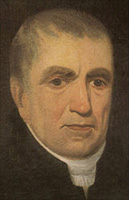
Edmund Ignatius
Rice
(1762-1844).
|
| |
Jesuit
monks were not required to wear the round tonsure. They
took 3 vows: poverty, chastity, and obedience.
Most
of them were recruited from the lowest dregs of society
and had little formal education.
The
vow of chastity meant that they promised never to marry!! |
|
|
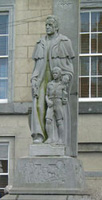
Statue of
Rice with one of his boys in Co. Kilkenny.
|
Edmund Rice looked
upon himself as the first general of the Order:
The community
moved closer to their goal on 15 August 1809 when, after an eight-day
retreat, and again in the presence of Dr Power, they made perpetual
rather than annual vows. On this occasion they also pledged themselves
to the charitable instruction of poor boys and each adopted a religious
name. Edmund Rice became Brother Ignatius after the Spanish hidalgo,
Ignatius Loyola, who founded the Society of Jesus and led the counter
reformation movement with a degree of piety, zeal and self-sacrifice
that astonished most of Europe. The proselytising campaign in Ireland
has been called the Second Reformation, and if this is a valid description,
it can be said of Brother Ignatius that his role in the Second Counter
Reformation was not dissimilar to that of Ignatius Loyola in the first.
(Rushe, Edmund Rice: The Man and His Times,
p. 48).
These men from the
very dregs of society were forbidden to marry which the Bible calls
a DOCTRINE OF DEVILS:
Now the Spirit
speaketh expressly, that in the latter times some shall depart from
the faith, giving heed to seducing spirits, and doctrines of devils;
Speaking
lies in hypocrisy; having their conscience seared with a hot iron;
Forbidding
to marry,
and commanding to abstain from meats, which God hath created to be
received with thanksgiving of them which believe and know the truth.
(I Timothy 4:1-3).
The
monks soon dispensed with their vows of poverty when they started charging
tuition to the parents of rich children. When the "free" State
was established in 1922, their reformatories were gold mines with the
children providing free labor and the financial subsidies granted by
the State.
Edmund
Ignatius Rice was a common BUTCHER!!
Not
much is known about the early life of Edmund Rice but the regular clergy
called him a common butcher. Just like the Jesuits, the lay monks under
Rice were not subordinate to the local bishops, and were the subject
of constant complaints to Rome:
But the campaign (against Rice) reached a new level
of malice when, in September 1818, a lengthy document was sent to
the Cardinal Prefect of Propaganda, allegedly bearing the signatures
of seventeen parish priests of the Waterford diocese: 'It may not
be amiss', it went in part, 'to give Your Eminence a brief outline
of Rice the Monk's life, in order to form an opinion of his now malicious
interference - this man sometime was a dealer in cattle and common
butcher in the streets of Waterford. Your Eminence will judge from
this, his slaughtering profession, of the savageness of his nature
and absence of tender sensibility and want of human feeling. This
impertinent intruder in the affairs of the sanctuary was of habits
irregular and of desires lustful....This is a truth we all know and
so do the laity of Waterford.... It is even known to some now living
in the city of Rome— ashamed of his misfortunes, he entered
on a religious life and how happy the change, if he be truly repented
and did not meddle in other people's concerns. Not still satisfied,
this wretched man's ambition also is to become a perpetual general
of his Institute in order to lord it over the priests and bishops,
to be under no control by the introduction of Benedict the 13th's
Bull into Ireland which we humbly protest against for piety sake.'
(Rushe, Edmund Rice: The Man and His Times, p. 70).
A
"free" State for pedophile monks!!
By
1920, these lay monks had established reformatories all over Ireland.
The reformatories were actually slave labor camps for children somewhat
like the Gulags in Russia.
Under
the British system, reformatories were phased out by the end of the
19th century. Children of broken homes were placed in foster care with
other families. Not so in Ireland. These corrupt monks wanted to have
access to the children at any cost.
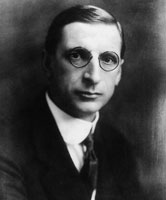
Britsh
spy Éamon de Valera (1882-1975).
|
| |
As
long as Ireland was part of the United Kingdom, the number
of young children available to the monks was severely
limited.
The
creation of the "free" state in 1922 changed
all that.
The
new government worked with the monks to incarcerate young
children behind thick prison walls. |
|
|
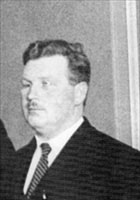
Thomas
Derrig
(1897-1956).
|
Thomas
Derring was Minister for Education from 1932 until 1939 and again from
1943 until 1948. He worked closely with de Valera and the Roman hierarchy
to ensure an endless supply of male and female children to the reformatories.
Upon
entering, all the children were given numbers and the "schools"
were run with military precision.
| 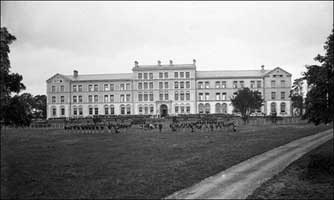 Artane Industrial
School in Dublin.
Artane Industrial
School in Dublin.
|
|
Most of the
young boys and girls committed to the reformatories were
orphans or came from broken homes. Judges sentenced them
to the prisons until they were 16 years old.
|
|
|
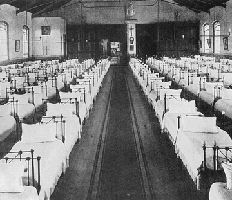
Military
style dormitories.
|
The
monks (who took vows of poverty) got a substantial sum from the government
for every child thus incarcerated.
Slave
labor and the substantial sums that they received from the government
made the reformatories veritable gold mines. These institutions for
boys and girls were found all over the country.
Father
Edward Flanagan became an advocate for the abused children!!
Despite
the strict censorship of the clerical regime, word began to reach the
outside world of the deplorable conditions in the reformatories.
In
the United States, letters reached a famous priest named Father Edward
Flanagan. Father Flanagan had opened a school for boys in Nebraska named
Boys Town. Father Flanagan was known for his advocacy of humane treatment
of children. He actually expelled the Jesuit monks from his school:
We
have no "Christian Brotherhood" here at Boys Town. We did
have them for five years but they left after they found out they could
not punish the children and kick them around. (Father Flanagan's
Legacy, p. 112).
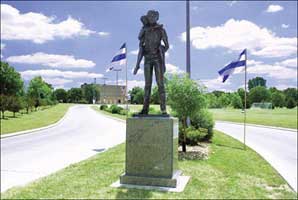
Boys
Town, Nebraska.
|
| |
Father
Edward Flanagan was an Irish born priest who opened Boys
Town in 1917.
Boys
Town grew until it eventually helped hundreds of needy
boys.
By
1945, Father Flanagan was one of the most famous priests
in the United States. |
|
|

Father
Edward Flanagan
(1886-1948).
|
Included
with the letters were photographs of escaped children with whip marks,
broken bones and bruises from the beatings of the merciless monks.
In
1946, Father Flanagan visited Ireland in person to see for himself the
conditions of the reformatories.
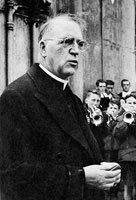
Father
Flanagan in Ireland, 1946.
|
| |
Great
crowds greeted Father Flanagan on his Irish tour.
He
was treated like a movie star, and indeed a Hollywood movie
had been made about his life and work.
His
main interest however was to investigate conditions in the
reformatories. |
|
|
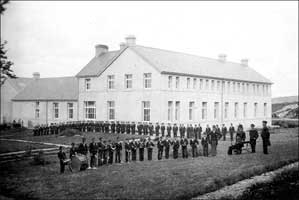
Baltimore
Fisheries School, in Co. Cork, Ireland.
|
Baltimore
Fisheries School, in Co. Cork, was the last reformatory to be visited
by Father Flanagan before he left for the U.S. at the end of July.
He
publicly castigated the reformatories and urged parents not to send
their children to those institutions:
Fr.
Flanagan was horrified to discover the widespread use of severe physical
punishment in industrial and reformatory schools (and in prisons)
in Ireland. In a statement issued to the press at the end of his visit
to Ireland in July 1946, he described these institutions as "a
disgrace to the nation."'
He had given a series of public lectures in cities around the country.
His packed audiences invariably included senior members of the Catholic
Church. In Limerick and Waterford, for example, the local bishops
were in attendance.
He used the opportunities provided to elaborate on his own child care
philosophy - to love, support and encourage the children in his care.
But he also contrasted the approach of Boys Town USA to the attitudes
towards children in care in Ireland. Addressing a packed audience
at the Savoy Cinema in Cork, he stated: "You
are the people who permit your children and the children of your communities
to go to these institutions of punishment. You can do something about
it, first by keeping your children away from these institutions."
These remarks brought prolonged applause from the audience.
The Irish Government, however, was not quite so ecstatic about Fr.
Flanagan's criticisms of its child care institutions. Fianna Fail's
Gerry Boland, the then Minister for Justice, responded angrily. In
Dail Eireann, on 23rd of July 1946, he accused Fr. Flanagan of using
"offensive and intemperate language" concerning "conditions
about which he has no firsthand knowledge." (Father
Flanagan's Legacy, p. 107).
The
Jesuit monks listened to his every word and saw their incomes greatly
threatened. When Erasmus of Rotterdam was asked why the Pope was persecuting
Luther, this was his timeless reply:
He
(Luther) hath touched the Pope's Crown and the bellies of
the monks.
It
seems that nothing has changed over the centuries.
Father
Flanagan was poisoned for exposing the pedophile monks!!
Father
Flanagan was determined to return to Ireland the following year and
thoroughly investigate the reformatories and the Irish adult
prison system.
Other
international commitments delayed his return, and it was not until 1948
that the door was opened for a return visit. He had already written
to the Irish government requesting permission to visit both adult and
children's prisons:
In
the middle of all this (international commitments), he had already
written to the Irish Government requesting permission to visit a substantial
number of penal institutions for both adults and children in the country.
He anticipated arriving in Ireland during the summer of 1948. (Father
Flanagan's Legacy, p. 114).
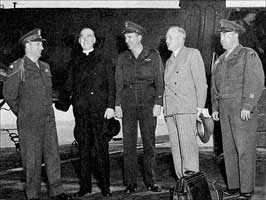
The last
picture: Arriving at Tempelhof Airfield,
Berlin, May 14, 1948.
|
| |
Father
Flanagan was scheduled to arrive in Ireland during the
summer of 1948.
He
never made it as he received the cup of Borgia and died
of a "heart attack" on May 15, 1948, |
|
|
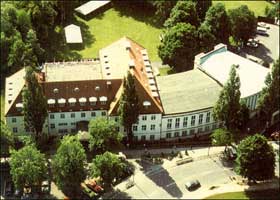
Harnnack-Haus
in Berlin where Father Flanagan died on the night of May 15.
|
With
the death of Father Flanagan, the one critic of the clerical
regime that they feared most was gone. The unholy cooperation between
the Jesuit monks and the government continued unabated:
His
untimely death effectively marked the end of this controversial public
debate surrounding the care of children in industrial schools. Almost
twenty years were to elapse before the issue once again came into
the public arena. In that twenty years, roughly 15,000 children served
out their time in industrial schools throughout the country, enduring
conditions which had changed little from those condemned by Fr. Flanagan
in 1946. (Father Flanagan's Legacy, p. 114).
With the timely
death of Father Flanigan, the lone voice for the poor suffering inmates
in the Gulags was hushed forever.
The
"Sisters of Mercy" were female Jesuits!!
The
"Sisters of Mercy" were the female equivalent of the "
Christian Brothers" or lay monks.

The "Sisters
of Mercy" were founded at the Mercy Intl. Center in 1831.
|
| |
The
"Sisters of Mercy" were founded by Catherine
McAuley in 1831.
These
"resurrected" female Jesuits, founded in Dublin,
were the equivalent of the lay Jesuit monks.
Their
convents included huge laundry establishments called Magdalene
Laundries. |
|
|
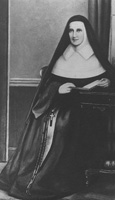
Catherine
McAuley
(1778 - 1831).
|
The Magdalene Laundries
were huge money-making establishments whose stated purpose was to rehabilitate
"fallen women." They were named after "ex-prostitute"
Mary Magdalene. Only the Latin Church refers to Mary Magdalene (correct
name Miriam of Magdala) as an "ex-prostitute."
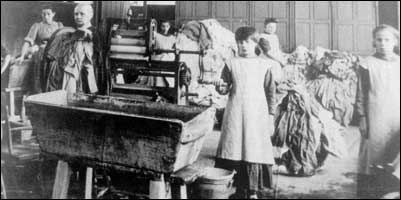
The Magdalene
Laundries were huge labor-intensive
factories run by "fallen women."
|
|
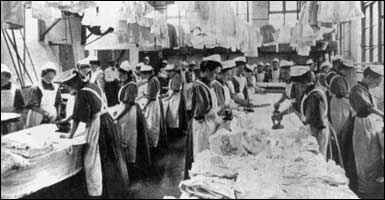
The Magdalene Laundries were a cash cow for
the "Sisters of Charity."
|
No commercial Irish
laundries could compete with the slave labor Magdalene Laundries staffed
by "fallen women."
In the clerical
"Republic," a fallen women was defined as someone who had
a baby out of wedlock . . . or a prostitute.....Obviously, the more
"fallen women" the government could supply to the nuns, the
greater the profit. As in the boys' homes, the courts and the police
worked together to ensure a steady supply of young victims to the female
Gulags.
The advent of electricity
put a big dent in these labor-intensive laundries and it could be said
that Mr. Tesla contributed to closing them down.
New
blasphemy law in Ireland
DUBLIN—July
10, 2009.
In
order to stifle criticism of the Jesuit regime in Ireland, the Irish
Parliament passed a Blasphemy Bill making it a crime to criticize any
religion. This bill is modeled after the blasphemy law in Saudi Arabia
which makes it a crime to speak out against the false religion of Islam.
Here is the text of the blasphemy bill:
| 36.
Publication or utterance of blasphemous matter.
(1) A person
who publishes or utters blasphemous matter shall be guilty of
an offence and shall be liable upon conviction on indictment to
a fine not exceeding €100,000. [Amended to €25,000]
(2) For
the purposes of this section, a person publishes or utters blasphemous
matter if (a) he or she publishes or utters matter that is grossly
abusive or insulting in relation to matters held sacred by any
religion, thereby causing outrage among a substantial number of
the adherents of that religion, and (b) he or she intends, by
the publication or utterance of the matter concerned, to cause
such outrage.
(3) It shall be a defence to proceedings for an offence under
this section for the defendant to prove that a reasonable person
would find genuine literary, artistic, political, scientific,
or academic value in the matter to which the offence relates.
37. Seizure
of copies of blasphemous statements.
(1) Where
a person is convicted of an offence under section 36, the court
may issue a warrant (a) authorising any member of the Garda Siochana
to enter (if necessary by the use of reasonable force) at all
reasonable times any premises (including a dwelling) at which
he or she has reasonable grounds for believing that copies of
the statement to which the offence related are to be found, and
to search those premises and seize and remove all copies of the
statement found therein, (b) directing the seizure and removal
by any member of the Garda Siochana of all copies of the statement
to which the offence related that are in the possession of any
person, specifying the manner in which copies so seized and removed
shall be detained and stored by the Garda Siochana.
(2) A member
of the Garda Siochana may (a) enter and search any premises, (b)
seize, remove and detain any copy of a statement to which an offence
under section 36 relates found therein or in the possession of
any person, in accordance with a warrant under subsection (1).
(3) Upon
final judgment being given in proceedings for an offence under
section 36, anything seized and removed under subsection (2) shall
be disposed of in accordance with such directions as the court
may give upon an application by a member of the Garda Siochana
in that behalf. |
Vital
Links
References
Arnold,
Bruce. The Irish Gulag: How the State Betrayed its Innocent Children.
Gill & Macmillian, Dublin, 2009.
Arnold,
Mavis & Heather Lskey, Children of the Poor Clares: The Story
of an Irish Orphanage. Appletree Press, Belfast, 1985.
Lonnborg,
Barbara A & Lynch, Thomas J. Father Flanagan's Legacy.
Boys Town Press, Boys Town, Nebraska.
O'Malley,
Kathleen. Childhood Interrupted: Growing Up Under the Cruel Regime
of the Sisters of Mercy. Virago Press, London, 2005.
Oursler,
Fulton & Will Oursler. Father Flanagan of Boys Town. Doubleday
& Co., Garden City, NY, 1948.
Raftery,
Mary & Eoin O'Sullivan. Suffer the Little Children: The Inside
Story of Ireland's Industrial Schools. Continuum, New York, 2001.
Rushe,
Desmond. Edmund Rice: The Man and His Times. Gill & Macmillan,
Goldenbridge, Dublin, 1981.
Copyright
© 2013 by Patrick Scrivener
Back
to Main Menu |















